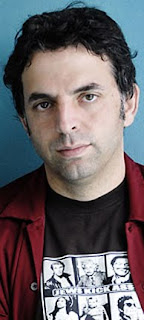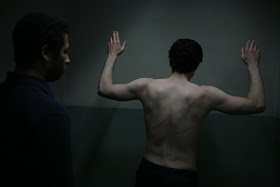Up to now, TrustMovies has not been an enormous fan of the animation technique known as claymation. Of course he's loved the Wallace & Gromit stuff, but beyond that, not a whole lot has appealed. Now that he has seen $9.99, the relatively new (2008) animated film from director/co-adapter Tatia Rosenthal (below, right) and Israeli writer Etgar Keret (below, left), all that has changed. This 78-minute, Australian/Israeli co-production seems a perfect fit for the claymation process. With its rough edges and let-the-seams-show animation, the look compliments Keret's characters -- slightly weird, off-kilter, and other-worldly -- to a "t." (The characters' voices belong to some of Australia's finest actors: Geoffrey Rush, Anthony LaPaglia, Claudia Karvan and Barry Otto.)
With its cast of connected people, all from the same apartment building, who inhabit stories that form a mosaic of life in a world that is both like and unlike our own, Rosenthal, Keret and the entire production staff have found the right mesh of tale and style, character and look to create something original, moving and funny. But sad and a little creepy, too (note the overstuffed furniture in the apartment of a supermodel). The creepiness comes, I think intentionally, from author Keret's pushing us to look at how we live and what we want -- and what has happened to us, what we give up, by the time we acquire our desire.
A homeless fellow accosts a man leaving for his morning work with unpredictable results. So begins a roundelay of connections & events that take in several fractured "families" (interestingly, these are made up of males only; the moms/wives are gone). There is also a young man, his fiance and a trio of tiny intruders; and (shown below) that supermodel and her new boyfriend who works as a re-possesser and is the older son of one of the aforementioned families.
Keret's subjects include human connection and the meaning of life -- no small potatoes in the theme category -- and while these have been done to death already, the writer finds some new wrinkles to explore and Ms Rosenthal's animation helps him do it with fantasy and reality, the real and the surreal coexisting side by side. (The surreally funny Wristcutters: A Love Story had a screenplay by Keret based on one of his short stories, and he also directed the odd and affecting film Jellyfish.)
In addition to the claymation figures, Rosenthal and her crew have devised some wonderful, small scale models that serve as sets and contrast exquisitely with the figures in the foreground (the cheesecake in the photo at bottom looks good enough to eat). The angles she shoots from (example below) cover the beautiful, amusing and dynamic, and her views of the apartment building by day or night (above) are exquisite.
The film's title -- $9.99 -- is the price of a book that promises the meaning of life that one of our young protagonists purchases and then, as usual, receives offers of more things to buy. Sounds like your typical advertising ploy? But wait: Sometimes what you see is what you get. You simply have to learn how to use it.
$9.99 is available now on DVD for sale or rental. I'd advise a viewing because this small, precise movie keeps opening up into something that finally compares to little else I've seen.














































